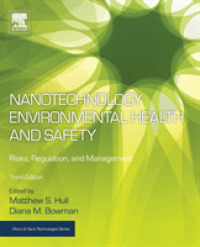- ホーム
- > 洋書
- > 英文書
- > Science / Mathematics
Full Description
For courses in Microbiology Lab and Nursing and Allied Health Microbiology LabA Flexible Approach to the Modern Microbiology LabEasy to adapt for almost any microbiology lab course, this versatile, comprehensive, and clearly written manual is competitively priced and can be paired with any undergraduate microbiology text. Known for its thorough coverage, straightforward procedures, and minimal equipment requirements, the Eleventh Edition incorporates current safety protocols from governing bodies such as the EPA, ASM, and AOAC. The new edition also includes alternate organisms for experiments for easy customization in Biosafety Level 1 and 2 labs. New lab exercises have been added on Food Safety and revised experiments, and include options for alternate media, making the experiments affordable and accessible to all lab programs. Ample introductory material, engaging clinical applications, and laboratory safety instructions are provided for each experiment along with easy-to-follow procedures and flexible lab reports with review and critical thinking questions.
Contents
Laboratory SafetyLaboratory ProtocolPart 1 Basic Laboratory Techniques for Isolation, Cultivation, and Cultural Characterization of Microorganisms1. Culture Transfer Techniques 2. Techniques for Isolation of Pure Cultures3. Cultural Characteristics of MicroorganismsPart 2 Microscopy 4. Microscopic Examination of Stained Cell Preparations5. Microscopic Exami na tion of Living Microorganisms Using a Hanging-Drop Preparation or a Wet MountPart 3 Bacterial Staining6. Preparation of Bacterial Smears7. Simple Staining8. Negative Staining9. Gram Stain10. Acid-Fast Stain11. Differential Staining for Visualization of Bacterial Cell StructuresPart 4 Cultivation of Microorganisms: Nutritional and Physical Requirements, and Enumeration of Microbial Populations12. Nutritional Requirements: Media for the Routine Cultivation of Bacteria13. Use of Differential, Selective, and Enriched Media14. Physical Factors: Temperature15. Physical Factors: pH of the Extracellular Environment16. Physical Factors: Atmospheric Oxygen Requirements17. Techniques for the Cultivation of Anaerobic Microorganisms18. Serial Dilution-Agar Plate Procedure to Quantitate Viable Cells19. The Bacterial Growth CurvePart 5 Biochemical Activities of Microorganisms20. Extracellular Enzymatic Activities of Microorganisms21. Carbohydrate Fermentation22. Triple Sugar-Iron Agar Test23. IMViC Test24. Hydrogen Sulfide Test25. Urease Test26. Litmus-Milk Reactions27. Nitrate Reduction Test28. Catalase Test29. Oxidase Test30. Utilization of Amino Acids31. Genus Identification of Unknown Bacterial CulturesPart 6 The Protozoa32. Free-Living Protozoa33. Parasitic ProtozoaPart 7 The Fungi34. Cultivation and Morphology of Molds35. Yeast Morphology, Cultural Characteristics, and Reproduction36. Identification of Unknown FungiPart 8 The Viruses37. Cultivation and Enumeration of Bacteriophages38. Isolation of Coliphages from Raw Sewage







